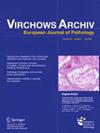具有不寻常组织学特征的局部浸润性并肾小球细胞瘤。
IF 3.1
3区 医学
Q1 PATHOLOGY
引用次数: 0
摘要
肾小球旁细胞瘤(JGCT)是一种极为罕见的肾脏肿瘤,临床表现以良性为主,组织学特征典型。它常见于青壮年,表现为与肾素分泌有关的高血压。我们报告一例最初被认为是肾细胞癌的JGCT。它的独特之处在于它的大小,高度的组织学特征和局部浸润性-延伸到肾盂。目前尚不清楚肿瘤坏死、多形性和增殖活性增加等特征是否预示着转移潜力和/或局部侵袭性行为。在这种情况下,可能需要进行临床随访。本文章由计算机程序翻译,如有差异,请以英文原文为准。
A locally infiltrative juxtaglomerular cell tumor with unusual histologic features.
Juxtaglomerular cell tumor (JGCT) is an exceptionally rare renal tumor with a predominantly benign clinical course and classically bland histology. It commonly presents in young adults and manifests as hypertension related to renin secretion. We report a JGCT initially thought to be a renal cell carcinoma. It was unique because of its size, high-grade histologic features and locally infiltrative nature-extension into the renal pelvis. It is unclear whether features such as tumor necrosis, pleomorphism and increased proliferative activity are predictive of metastatic potential and/or locally aggressive behavior. Clinical follow-up may be warranted in such cases.
求助全文
通过发布文献求助,成功后即可免费获取论文全文。
去求助
来源期刊

Virchows Archiv
医学-病理学
CiteScore
7.40
自引率
2.90%
发文量
204
审稿时长
4-8 weeks
期刊介绍:
Manuscripts of original studies reinforcing the evidence base of modern diagnostic pathology, using immunocytochemical, molecular and ultrastructural techniques, will be welcomed. In addition, papers on critical evaluation of diagnostic criteria but also broadsheets and guidelines with a solid evidence base will be considered. Consideration will also be given to reports of work in other fields relevant to the understanding of human pathology as well as manuscripts on the application of new methods and techniques in pathology. Submission of purely experimental articles is discouraged but manuscripts on experimental work applicable to diagnostic pathology are welcomed. Biomarker studies are welcomed but need to abide by strict rules (e.g. REMARK) of adequate sample size and relevant marker choice. Single marker studies on limited patient series without validated application will as a rule not be considered. Case reports will only be considered when they provide substantial new information with an impact on understanding disease or diagnostic practice.
 求助内容:
求助内容: 应助结果提醒方式:
应助结果提醒方式:


